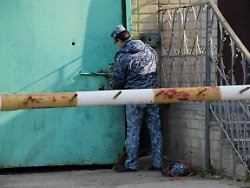Wednesday, November 03, 2021
Torture videos from prisons
The Gulag system lives on in Russia
At the beginning of October, Sergei Saveliev published recordings of brutal scenes from a Russian prison hospital. The extent of the violence caused widespread horror, the videos were clicked millions of times. There are hardly any consequences. The whistleblower, on the other hand, now fears for his life.
Since his release from prison in the Russian Volga metropolis Saratov, Sergei Saveliev has feared for his life. The young man smuggled vast amounts of video material out of jail in order to make the depths of the prison system public. “There are videos full of terrible, sadistic scenes,” says the 31-year-old, who was granted asylum in France. You can see naked, bound prisoners who are tortured in every possible way.
The fact that prisoners are being tortured in Russia is nothing new. But the extent that is now becoming known exceeds everything imaginable, as Vladimir Ossetschkin from the human rights project Gulagu.net says. He repeatedly publishes pixelated and highly regarded images of the brute force in prison camps on social networks. In particular, the videos published in early October from the number one prison hospital in Saratov caused widespread horror.
Saveliev worked there in video surveillance – and thus had access to the files. After his release, he handed them over to Ossetschkin, who had left Russia in 2015. Ossetschkin named his organization after the camp system founded under Soviet dictator Josef Stalin, which the writer Alexander Solzhenitsyn (1918-2008) once described in his work “Archipel Gulag”. The name Gulag is gone, but even Russian government politicians sometimes complain that the system is basically still going on.
The “hero of a new type”
Savelyev and Ossetschkin have found political asylum in Biarritz, the seaside resort in southwest France. You talk to the international media almost every day, you work with documentary filmmakers. Their goal is to make the biggest exposure of violence in Russian prisons to date public. Russia’s star presenter Xenia Sobchak just met Savelyev in France for an interview for her video channel. She calls him a “new type of hero” and places him in a row with whistleblowers who make state grievances public. She called her film a “100 gigabyte bomb” in view of the amount of data.
Abused prisoners who report a system of fear and looking away also have their say. More than two million people have viewed the film on Youtube so far. In other countries such scandals would topple governments, says Sobchak. But not in Russia. It is true that the officials accused by Savelyev have been released from prison. So far, however, there have been no arrests. Instead, the judiciary issued an arrest warrant for Saveliev and put him out to be wanted. Russia’s media supervisory authority Roskomnadzor is also trying to have the videos blocked online, for example on YouTube.
Saveliev, a native of Belarus, many acknowledge, risked his life to publish the material. And yet voices like those of the Russian government’s human rights commissioner, Tatiana Moskalkova, who praised his courage, are rare. Saveliev and Ossetschkin say they have received death threats. You can contact them via Facebook. The 40-year-old Ossetschkin is combative: “We’re going on.” Both know that Russia’s intelligence services have a long arm. The list of murdered Russian government critics is long. Ossetschkin accuses the penal system and the domestic secret service FSB of having created a system of oppression and humiliation. “Although everyone can see what is going on in the prison camps, there is no objective investigation,” he says. “Rather, it is clear that they want to destroy us.”
Violence also emanates from fellow prisoners
But there are other informants. The publications should continue. “The system always acts in the same way: those who tell the truth are persecuted,” says Saveliev, who sees himself denigrated as a “traitor” and “enemy of the state”. He has published names of the alleged perpetrators of the prison system. Often, however, the guards would not perpetrate the violence themselves, but fellow prisoners.
Human rights activists see several reasons for the torture. Prisoners resorted to violence against their fellow inmates in order to buy benefits such as milder sentences, early release or even alcohol. Recordings of torture were also used as a deterrent to extort money from prisoners. Sometimes criminals can also order punitive actions against their enemies in prison, it is said. The violence is used not least to break offenders, to re-educate them or to extort a confession. Investigators who present guilty parties can hope for bonuses and promotion.
In an open letter to Vladimir Putin, Ossetschkin recently asked whether the Kremlin chief knew that generals and officers were “fooling him” and that they were doing nothing to counter the violence. Or whether the president himself knows – and “personally allows the torture”. There is no answer to that. “The extent of torture, corruption, inhuman treatment and murder surpasses everything. The world is now seeing these massive crimes,” says Ossetschkin. Among other things, he calls for a harsher punishment for torture in the penal system in Russia and an end to the persecution of those who make grievances public.
The moderator Sobchak thinks that the whole system must be broken up and rebuilt from scratch. But the prominent human rights activist Olga Romanowa, who campaigns for the rights of prisoners, has no hope. Perhaps Savelyev’s revelations led to less torture for a short time. “But there are no illusions that anything can be changed. The penal system itself is a violation of human rights.”
